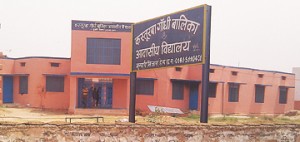Muslims are not benefitting from these centrally-funded schools in due measure.
By Maqbool Ahmed Siraj
Muslim girls accounted for only 213 among the 700 girls in Kasturba Gandhi Balika Vidyalayas in Rampur district of Uttar Pradesh.

Large number of Kasturba Gandhi Balika Vidyalayas (Girls Schools named after Kasturba Gandhi) have been established across the country during the last nine years. These are being set up by the Union Government under the National Programme for Education of Girls (NPEGL) launched under Sarva Shiksha Abhiyan or what is now commonly known as “Education for All Campaign” and abbreviated as SSA.
Five years ago, a high-level HRD Ministry official had indicated that there were only 1,800 Muslim girls among total 55,000 then enrolled in these schools. He was speaking at Women’s education seminar in Jamia Millia Islamia in New Delhi.
Since then the number of these schools and total enrolment has gone up manifolds. Yet not much awareness is found among Muslims about the existence of these centrally-funded special schools for girls all across the nation. A micro-level study by Mr. Afzal Sayeed and Hajra Masood, research scholars at the Department of Sociology at the Aligarh Muslim University has tried to find out the Muslim representation in these schools in Rampur district of Uttar Pradesh.
Kasturba Gandhi Balika Vidyalayas (KGBV) are basically residential schools specially designed for girls from the SC, ST, OBC and Minority communities and for girls from the Below the Poverty Line (BPL) families. As per SSA website updated till May 2009, there are 2,578 such schools around the country. Of these, 427 KGBVs have been sanctioned in 726 Muslim concentration blocks, 612 in ST blocks, 688 in SC blocks. 75% entrollment in these institutions is reserved for girls from SC, ST, OBC and Minority communities and the other 25% for girls from families below the poverty line from other social groups.
The SSA website reporting the progress of the KGBVs up to July 15, 2009 informs that a total of 23,231 girls were enrolled in 397 KGBV schools which were operational till then (against the sanctioned 427 schools) in 726 Community Development Blocks and 94 towns having a Muslim representation of 20 per cent and above. Of the total, 6,047 or 26% girls were from the Muslim community. A statewise break-up of (in major states) these schools was as follows: Assam 12, Bihar 60, Uttar Pradesh 177, Jharkhand 22, Jammu and Kashmir 56,West Bengal 17, Karnataka 4, Rajasthan 23, Gujarat, Haryana and Uttaranchal 7 each, Andhra Pradesh 12, Madhya Pradesh 1, Orissa and Punjab one each and Kerala, Maharashtra and Tamil Nadu none.
This was however the national picture in 2009. However, the AMU study focused merely on Rampur district of Uttar Pradesh, one of the most educationally backward districts in UP. The district population stood at 19.23 lakh in 2001. Half of the people were Muslims with an average literacy of 33 per cent.
There were seven Kasturba Gandhi Balika Vidyalayas functioning in the district in 2009-10. Six of these schools were being managed by NGOs while remaining one was being managed by the District Institute of Educational Training (DIET). Each of the seven schools were located in seven blocks namely Shahabad, Chamrauwa, Suar, Ramput City, Milak, Bilaspur, and Saidnagar. The study says the official district statistic revealed that there were 250 Muslim girls among the total 713 enrolled in these seven schools. This made up 35% of the total while the Muslims represented 49% of the district population.
But official information was not corroborated by the information provided by the Wardens which put the total number of students on rolls to be 700 and the number of Muslim girls at 200 and Sikh girls at 11. While the total enrollment figures were only marginally different, there was major discrepancy in the number of Muslims girls which were officially shown as 250. Investigators reported difficulties in procuring the exact figures and had to rely on what was revealed unofficially. If the unofficial figures are relied upon, the Muslim representation plummets to 28 per cent in a district where nearly half the population is Muslim.
Wardens are supposed to be the administrators in these schools. Apart from 7 wardens there were 24 full-time and 23 part-time teachers in these schools. Of them there were only two full-time and seven part-time Muslim teachers. None of the schools was an Urdu medium school although Urdu was taught as a language in all of them.
The study alleges discrimination against Urdu and cites underrepresentation of Muslims in a Muslim dominated district. However, it will be difficult to agree with the allegation of discrimination against Urdu. The KGBVs being meant for Educationally Backward Blocks (EBBs) will have to perforce follow a language medium which is more relevant to the state where it functions. Urdu medium may be beneficial to Muslims, but would jeopardize its prospects of addressing the issue of illiteracy among girls in wider sections of the society consisting of SCs, STs, OBCs and the Minorities.

COMMENTS